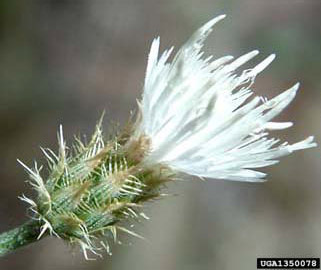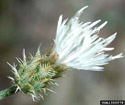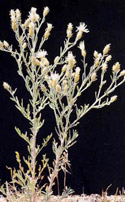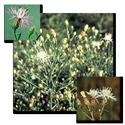Diffuse Knapweed
Centaurea diffusa • Class B |
||
| Family Name: | Asteraceae family (ass-ter-AY-see-ee) | |
| Common: | Aster, daisy, or sunflower family | |
| Genus: |
Centaurea (sen-TAR-ee-uh) Meaning: Latin, referring to the Centaur Chiron who discovered the medicinal use of the Centaury plant |
|
| Species: |
diffusa (dy-FEW-sa) Meaning: Loosely spreading |
|
| Description: |
Diffuse knapweed is a bushy, taprooted bienniel or short-lived perennial. It grows from 8 to 40 inches tall, with branching stems covered in short, dense hairs and a very long tap root. Its basal leaves (leaves at the stem base) have short stalks and grow 7 to 8 inches long. It has smaller stem leaves that are stalkless and reduce in size growing up the stems. Flowers are white to lavender and grow out of urn-shaped bracts at the tips of the many branches. The bracts are leathery and yellowish green with obvious veins and are edged with a fringe of spines, plus a longer spine/thorn at each tip. |
| Why Is it a Noxious Plant? |
It decreases plant diversity and wildlife habitat due to its competive nature, it also increases soil erosion and creates wildfire hazards. Diffuse knapweed releases a chemical which suppresses the growth of other species enabling it to create a monoculture. |
| Where Does it Grow? |
Diffuse knapweed invades along roadsides, on disturbed land and in waste places, often on gravelly, or light soil. It has shown wide adaptability, but does not tolerate flooding or shade. |
| Facts: |
It decreases the value of hay and can decrease the value of the land.
Losses due to Diffuse knapweed include soil erosion, wildlife population reduction, soil and water resource depletion, native species reduction, biodiversity reduction, and the disflavoring of milk. |
| Control Options: |
|
| More Information: |
For more information on this noxious weed Download our Flyer or visit Washington State Noxious Weed Control Board Here. Photo by Leo Michels
|
| More Pictures: |




